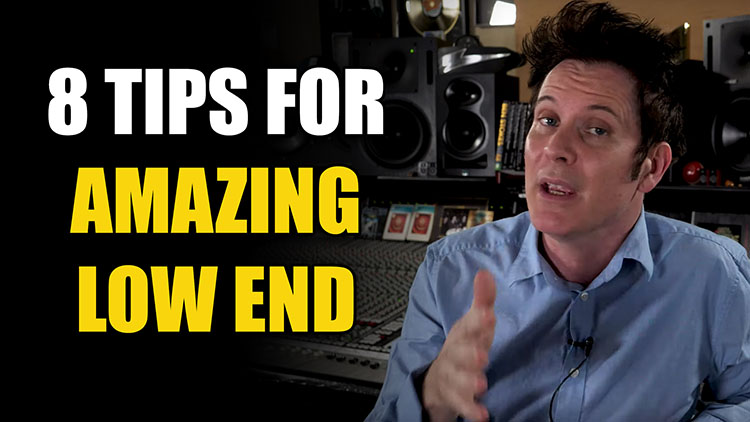Mixing low end can be tricky, and it is something we get a lot of questions about! Today I will be sharing some tips and tricks that you can use to get great low end in your mixes!
We also have a cheat sheet for you which will outline all the tips I share in the video. Download this cheat sheet so you can keep these tips handy and pull them out whenever you need them!
Click here to download the cheat sheet!
Now let’s get into the tips!
1. Monitoring – Can you hear the lows?
You can’t mix what you can’t hear! If you are in a small room and using small speakers, you may not be able to hear the low end through your speakers.
In cases like these, a subwoofer can be a useful tool, if you don’t know your room super well, the subwoofer can add to the problem and make the low end sound too aggressive or too soft. The biggest things is to know your room and make sure it is set up properly. Try to make sure that the spot that everything sounds right is from your seating position.
This can be difficult, though! Another strategy is to listen to your mix in other environments, as well as on headphones. Once you’ve got the low end to translate on many different sound systems, you will start to understand how it should sound in your own room.
2. Not All Low End Mix Tips are Created Equal
Mixing a live recorded Bass Guitar is very different from mixing a programmed bass line, also mixing a live Kick Drum is very different from mixing a programmed one.
When you are mixing programmed instruments, they will be totally even and consistent. When mixing a live instrument, there will be variations! Keep in mind that not every tip works in every situation.
3. Use A Frequency Analyser
Using a Frequency Analyser will really help you learn what you’re hearing, especially if you’re working in an untreated room with issues and using headphones that don’t have an accurate low end.
Using a frequency analyser will help you to hear the super low lows that your small speakers or headphones can’t pick up. It is super helpful to be able to see where there might be some weird spikes you might need to fix, but can’t hear on your speakers.
4. Don’t Boost What You Can’t Hear
If you work mainly on 4, 5 or 6 inch monitors you can create great mixes as long as you understand you won’t be reproducing super lows through those smaller speakers. Don’t boost the frequencies that the speakers can’t reproduce effectively, if you do boost them and they start to become audible then you end up with excessive low end which will become evident in other systems.
Go to places where you can hear it, or use headphones. Moving between speakers and headphones can be a great way to hear things you can’t hear on your speakers.
5. Don’t be afraid to high pass!
If you’ve got a ton of vocals and instruments and other things that have excessive low end, high passing these will let the true low end – the bass and kick – breathe naturally. This will allow your low end to be super clear and full.
Also remember to take care of your high passing on individual channels rather than trying to fix on the stereo master bus.
6. Evening out Low End on Organic Instruments
Plug ins like Waves RBass not only adds consistent low end it also adds harmonics, which (particularly on programmed sounds) can add extra sonic characteristics to your bass sound. Programmed Bass Synths and Bass Guitars will stand out of the mix more if you add definition by adding presence, high mids and even saturation.
7. Keep Your Low Lows Mono
High frequencies are very directional, low lows are not. Keeping the kick drum and bass centred and removing low information from the sides will help them feel firmly in the sides, giving your mix more width.
8. Solve Your Problems inside of the Mix, not on your Master Bus
It is much better to find the issues inside of the mix and deal with them at their source. Trying to fix low end on your Master Stereo Bus (Mix Bus) should be a last resort, removing above 20hz will severely remove real low end and compromise your mix. So if you feel like you’re reaching for this area then look for the cause inside of the mix, looking at the individual elements that generate the low end.
With these tips, you can be sure to have great low end in all your mixes!
Watch the full video below to learn more about these tips and see how to put some of them into action in your mixes!
